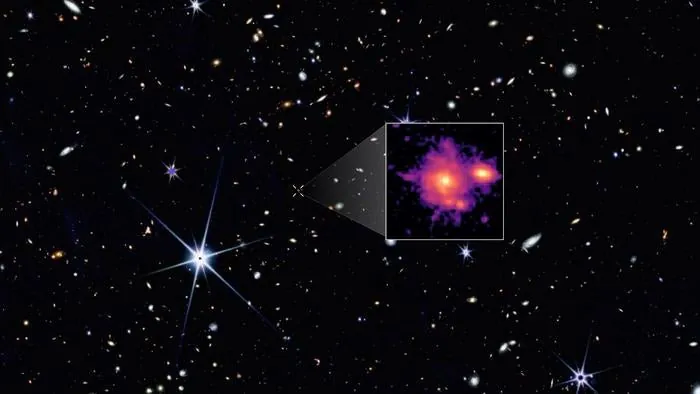
Discover the Cosmic 'Torch Dragon': A Distant Spiral Galaxy Defying All Expectations!
2025-06-13
Author: Michael
A Stellar Revelation in the Early Universe
In the depths of the early universe, a spectacular spiral galaxy known as Zhú lóng—meaning "Torch Dragon" in Chinese mythology—has emerged, casting new light on our understanding of cosmic history. This remarkable formation came into existence just a billion years after the Big Bang, challenging everything we thought we knew about galaxy evolution.
Shattering Preconceived Notions of Galaxy Formation
Historically, galaxies were believed to start as chaotic blobs, gradually gaining structure over billions of years. The concept of large, structured galaxies like our Milky Way developing rapidly was considered impossible. Enter the James Webb Space Telescope (JWST), which has unveiled startling revelations about the universe's earliest cosmic structures.
Meet Zhú lóng: A Cosmic Giant!
Zhú lóng astonishes astronomers with its extraordinary features. Discovered in a JWST study known as the PANORAMIC survey, this massive galaxy already possesses a defined bulge, bright spiral arms, and a well-developed disk that stretches approximately 60,000 light-years—nearly identical to the size of our own Milky Way!
Lead researcher Dr. Mengyuan Xiao noted, "What makes Zhú lóng particularly remarkable is how closely it resembles the Milky Way in shape, size, and stellar mass." This galaxy boasts over 100 billion solar masses in stars, showcasing a stellar mass surface density approximately ten times that of other galaxies of its age.
Vibrant Colors and Unique Characteristics
The galaxy's captivating colors tell a fascinating story. While its center glows red, indicating older stars with less active star formation, the outer regions are hotspots of star creation. This unusual color distribution suggests that Zhú lóng is developing from the inside out, mirroring the evolutionary paths of more modern spiral galaxies.
Chance Discovery Unveils New Cosmic Horizons
Interestingly, Zhú lóng wasn't the primary target of the PANORAMIC survey. It was an accidental find, demonstrating the sheer potential of this method for uncovering rare, distant galaxies that challenge existing models of galaxy formation, according to Dr. Christina Williams, a leading figure in the study.
A Rate of Star Formation That Defies Logic
Despite its impressive size, Zhú lóng has a surprisingly slow star formation rate—about 66 solar masses per year, which is ten times lower than the typical dusty galaxies from that epoch. Yet, it has achieved full size and structural maturity far faster than expected, converting about 30% of its baryonic gas into stars.
Revolutionizing Our Understanding of Galaxy Evolution
The JWST continues to upend long-held views on when galaxy structures can form. Before its discoveries, astronomers believed that well-formed disk galaxies like Zhú lóng wouldn’t appear until the universe was at least 3 billion years old. Now, evidence shows galaxies with disk-like structures presenting themselves at even redshifts above 5, indicating their existence in a much younger universe.
The Galactic Diversity Unveiled by JWST
Zhú lóng is not alone in this cosmic revelation. The JWST has illuminated the existence of other early galaxies, some compact and tranquil while others like Zhú lóng are bright and bursting with active star formation. This suggests a rich variety in the developmental pathways of galaxies, influenced by their unique environments and histories.
A Call to Rethink Cosmic Timelines
What does Zhú lóng signify? It urges a reevaluation of cosmic timelines. If galaxies can attain such size and complexity at astonishing speeds, the processes of galaxy formation must be more powerful than previously imagined. Future observations from JWST, alongside the Atacama Large Millimeter/submillimeter Array (ALMA), are set to delve deeper into Zhú lóng's star formation, gas composition, and spiral dynamics.
Conclusion: The Torch Dragon Lights the Way!
Zhú lóng is more than just a distant galaxy; it's a beacon of change in our understanding of cosmic formation. As the JWST ventures further, the Torch Dragon illuminates a vibrant path towards a greater comprehension of our universe's majestic past. Are we ready to embrace this new paradigm?









 Brasil (PT)
Brasil (PT)
 Canada (EN)
Canada (EN)
 Chile (ES)
Chile (ES)
 Česko (CS)
Česko (CS)
 대한민국 (KO)
대한민국 (KO)
 España (ES)
España (ES)
 France (FR)
France (FR)
 Hong Kong (EN)
Hong Kong (EN)
 Italia (IT)
Italia (IT)
 日本 (JA)
日本 (JA)
 Magyarország (HU)
Magyarország (HU)
 Norge (NO)
Norge (NO)
 Polska (PL)
Polska (PL)
 Schweiz (DE)
Schweiz (DE)
 Singapore (EN)
Singapore (EN)
 Sverige (SV)
Sverige (SV)
 Suomi (FI)
Suomi (FI)
 Türkiye (TR)
Türkiye (TR)
 الإمارات العربية المتحدة (AR)
الإمارات العربية المتحدة (AR)